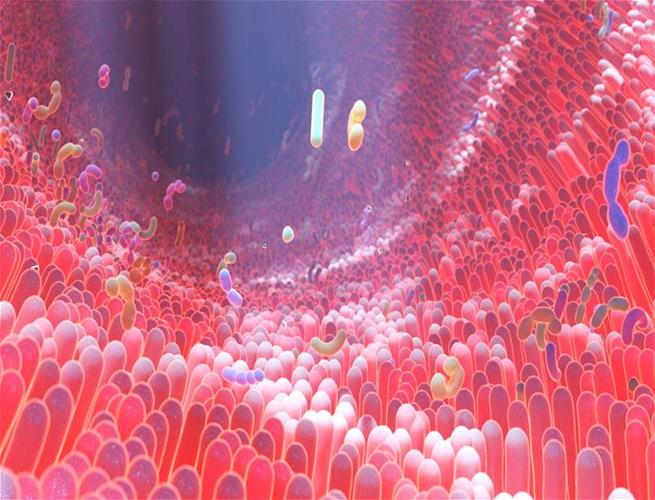FLYING UNDER THE RADAR: MULTI-DRUG-RESISTANT BACTERIA HIDES AMONG GUT BACTERIA OF ASYMPTOMATIC HUMAN CARRIERS
3 OCTOBER 2022
A 3D representation of the human gut microbiome where CPE and diverse bacteria reside. (Credit: A*STAR’s Genome Institute of Singapore)
SINGAPORE – Scientists from A*STAR’s Genome Institute of Singapore (GIS) have discovered how Carbapenemase-producing Enterobacteriaceae (CPE)—a multi-drug-resistant bacteria—hides among gut bacterial communities in asymptomatic human carriers. The study was published in Nature Microbiology on 15 September 2022.
Long-term colonisation of the gut microbiome by CPE, a family of bacteria resistant to most antibiotics, is a growing area of public health concern as it can lead to community transmission and life-threatening CPE infections. Individuals may experience CPE bacteria colonisation (e.g. E. coli or K. pneumoniae) through contact with contaminated surfaces or consumption of contaminated foods; prolonged consumption of antibiotics can also be a risk factor for colonisation. Some individuals can develop CPE infections, and treatment often involves using several antibiotics of “last resort”. In some severe cases, treatment failures lead to a high mortality rate (up to 50%) in hospitalised patients.
One place where scientists believe CPE hides is in the human gut, colonising it asymptomatically and masked by the trillions of good bacteria there, waiting for the opportunity to cause infections or transmit to other individuals.
To study the effects of CPE colonisation, and subsequent decolonisation on the gut microbiome, the team collaborated with Tan Tock Seng Hospital (TTSH) to examine the gut microbiome of CPE-positive subjects and their family members for one year. They tracked the gut bacteria by analysing their metagenomic DNA signatures and discovered that CPE is not completely silent in the gut. The team found that CPE colonisation leaves tell-tale marks by depleting key bacteria whose functions are linked to maintaining gut health by keeping inflammation in check.
The team also discovered that CPE colonisation was dynamic, and could potentially lead to the exchange of genetic elements that confer antibiotic resistance across bacterial species. By analysing the whole genome sequences of CPE strains, they found mutations in key functional genes, and differences in antibiotic resistance profiles between highly similar Escherichia coli (E. coli) and Klebsiella pneumoniae (K. pneumoniae) strains that could explain why CPE is able to successfully hide in the gut. Rebalancing gut bacteria, particularly in terms of key species that modulate gut inflammation could provide an avenue for promoting CPE decolonisation, and preventing onward transmission of antibiotic resistance.
Dr Niranjan Nagarajan, Group Leader of the Laboratory of Metagenomic Technologies and Microbial Systems and Associate Director of Genome Architecture at GIS, as well as corresponding author of the study, said, “Antimicrobial resistance is a major public health challenge with a large impact on healthcare systems in Singapore. Our study sheds light on an important phenomenon that is of concern to infectious disease clinicians around the world. CPE are particularly worrisome in terms of antimicrobial resistance because they carry the resistance genes on mobile elements1 that can be exchanged between bacteria, thus rapidly creating superbugs out of otherwise harmless bacteria. They are like deadly assassins hiding in plain sight among gut bacteria. Yet, their presence does not go unnoticed by the gut bacterial crowd, and perhaps the key to eliminating them is to harness the power of the crowd.”
Dr Jonathan Teo Jin Yuan, Research Fellow at the Laboratory of Metagenomic Technologies and Microbial Systems in GIS, and joint first author of the study, said, “Prior studies on CPE focused largely on the epidemiology and molecular aspects of the infection, but the natural history of CPE gut colonisation has remained unexplored. Our study was unique as it followed up with CPE-colonised patients and their family members for a year, allowing us to track changes in their gut bacterial communities. We used cutting-edge metagenomic technologies to deeply probe the genetics of their gut bacteria, track the changes at the whole-genome level, and subsequently, analysed how their gut bacterial communities evolved in relation to colonisation by CPE.”
Prof Patrick Tan, Executive Director of GIS, said, “Antimicrobial resistance is often spoken of as the next pandemic threat that could overwhelm healthcare systems worldwide. Among the organisms of concern, CPE are close to the top of the list because of their ability to transmit antibiotics resistance and colonise the human gut, even in the absence of overt infection and antibiotic usage. By studying CPE gut colonisation using advanced genomic tools, we were able to discover key insights that could help us reduce gut colonisation, prevent the spread of these pathogens, and hence, safeguard our community and healthcare systems.”
For media queries and clarifications, please contact:Genome Institute of Singapore, A*STAR
Lyn Lai
Senior Officer, Office of Corporate Communications
Genome Institute of Singapore, A*STAR
Tel: +65 6808 8258
HP: +65 8755 8759
Email: laiy@gis.a-star.edu.sg
About A*STAR’s Genome Institute of Singapore (GIS)
The Genome Institute of Singapore (GIS) is an institute of the Agency for Science, Technology and Research (A*STAR). It has a global vision that seeks to use genomic sciences to achieve extraordinary improvements in human health and public prosperity. Established in 2000 as a centre for genomic discovery, the GIS pursues the integration of technology, genetics and biology towards academic, economic and societal impact, with a mission to "read, reveal and write DNA for a better Singapore and world".
Key research areas at the GIS include Precision Medicine & Population Genomics, Genome Informatics, Spatial & Single Cell Systems, Epigenetic & Epitranscriptomic Regulation, Genome Architecture & Design, and Sequencing Platforms. The genomics infrastructure at the GIS is also utilised to train new scientific talent, to function as a bridge for academic and industrial research, and to explore scientific questions of high impact.
For more information about GIS, please visit www.a-star.edu.sg/gis.
About the Agency for Science, Technology and Research (A*STAR)
A*STAR is Singapore's lead public sector R&D agency. Through open innovation, we collaborate with our partners in both the public and private sectors to benefit the economy and society. As a Science and Technology Organisation, A*STAR bridges the gap between academia and industry. Our research creates economic growth and jobs for Singapore, and enhances lives by improving societal outcomes in healthcare, urban living, and sustainability. A*STAR plays a key role in nurturing scientific talent and leaders for the wider research community and industry. A*STAR’s R&D activities span biomedical sciences to physical sciences and engineering, with research entities primarily located in Biopolis and Fusionopolis. For ongoing news, visit www.a-star.edu.sg.
Follow us on
Facebook | LinkedIn | Instagram | YouTube
A*STAR celebrates International Women's Day

From groundbreaking discoveries to cutting-edge research, our researchers are empowering the next generation of female science, technology, engineering and mathematics (STEM) leaders.
Get inspired by our #WomeninSTEM
.jpg?sfvrsn=2e525642_4)
